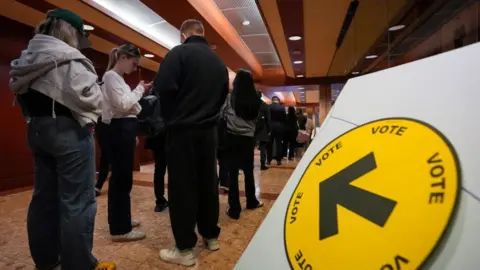The recent federal election in Canada has surprisingly resulted in significant changes within the political landscape, with about one in six seats shifting hands, as reported by Elections Canada. While the governing Liberal Party maintained its hold on power, the results signal a departure from business as usual, indicating substantial volatility within the political arena. Notably, this election marked a remarkable increase in the turnover of seats, with preliminary results showing that 17%—or 59 out of the 343 available seats—were claimed by rival parties, contrasting a mere 7% turnover observed in the 2021 elections.
The latest elections not only resulted in changes in party representation but also showcased the struggles of key leaders. A notable aspect of this election was the dramatic downfall of prominent figures such as Pierre Poilievre, the leader of the Conservative Party, who had been poised as a potential prime minister only three months prior when his party had a strong lead in the polls. Poilievre lost his seat in Carleton, Ontario, to a Liberal candidate, marking a significant shift in his political fortune. Additionally, NDP leader Jagmeet Singh stepped down after failing to secure a seat in Burnaby Central, British Columbia, while Jonathan Pedneault, the co-leader of the Green Party, finished fifth in Outremont, Quebec.
In contrast, Yves-François Blanchet of the Bloc Québécois and Elizabeth May, the other Green co-leader, successfully retained their seats, while Mark Carney secured a seat as a new MP for the Liberals. The fact that all 59 contested seats shifted to either the Liberals or Conservatives illustrates a shifting preference among the electorate away from smaller parties, impacting the representation and funding opportunities that these parties typically rely on in Parliament.
The election’s results further revealed that the NDP encountered a considerable setback, losing 17 of the 24 seats they were defending; a striking contrast to prior expectations. With only seven of those losses to the Liberals and ten to the Conservatives, the NDP fell short of the twelve seats necessary for acquiring official party status. This translates to a reduction in their parliamentary support, limiting their capacity for engaging in government oversight and legislative processes. Meanwhile, the Bloc Québécois experienced losses as well, dropping 13 of its previously held 35 seats, primarily to the Liberals.
Suburban areas, particularly around Montreal and Toronto, saw shifting allegiances with many constituencies flipping their support. For instance, in Quebec, riding Terrebonne successfully flipped from Bloc Québécois to the Liberals by a narrow margin. The voter demographics and preferences in regions sharing similar characteristics indicated a larger trend towards the Liberals, consolidating their power.
Despite the Chairpositions of the Liberal Party experiencing turbulence themselves by losing 16 seats—double the amount lost in the last election—the party was able to navigate these challenges relatively successfully. The Conservatives, on the other hand, witnessed the loss of twelve of their MPs, including their leader Poilievre, which pointed towards a difficult future as the party refines its strategies and solidifies its core message for voters.
In conclusion, the outcome of the Canadian election not only intensified the rivalry between the major parties—the Liberals and Conservatives—but also underscored the precariousness of party leadership within the context of electoral accountability. The overall shifts in the political map speak to changing voter sentiments, reflecting broader concerns and expectations within Canadian society. With crucial implications for parliamentary dynamics and governance in Canada, the 2025 federal election results compel all parties to reassess their strategies and engage more closely with the electorate in a rapidly evolving political landscape.



